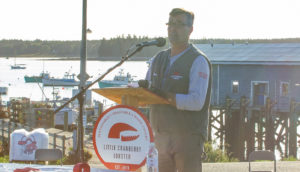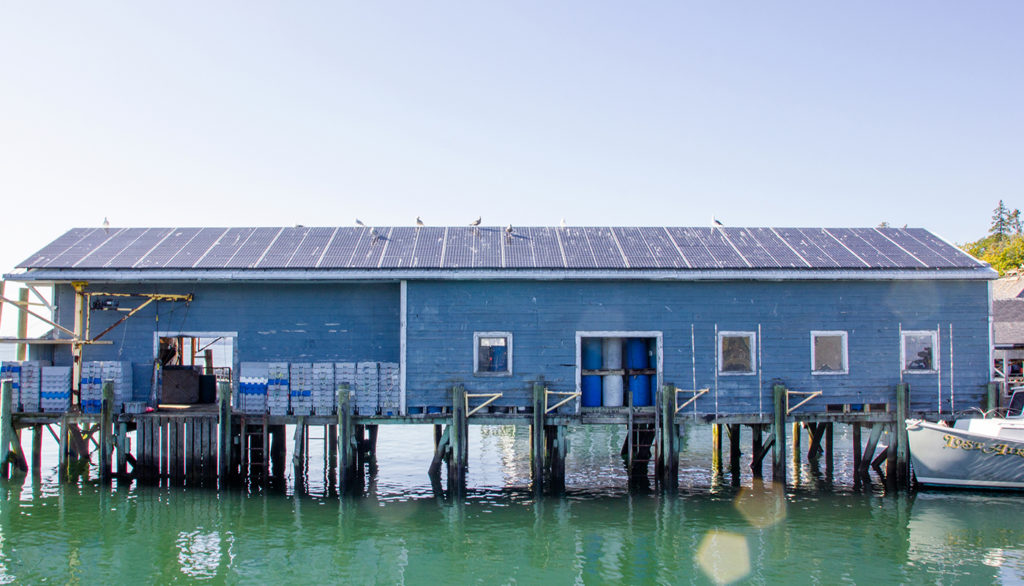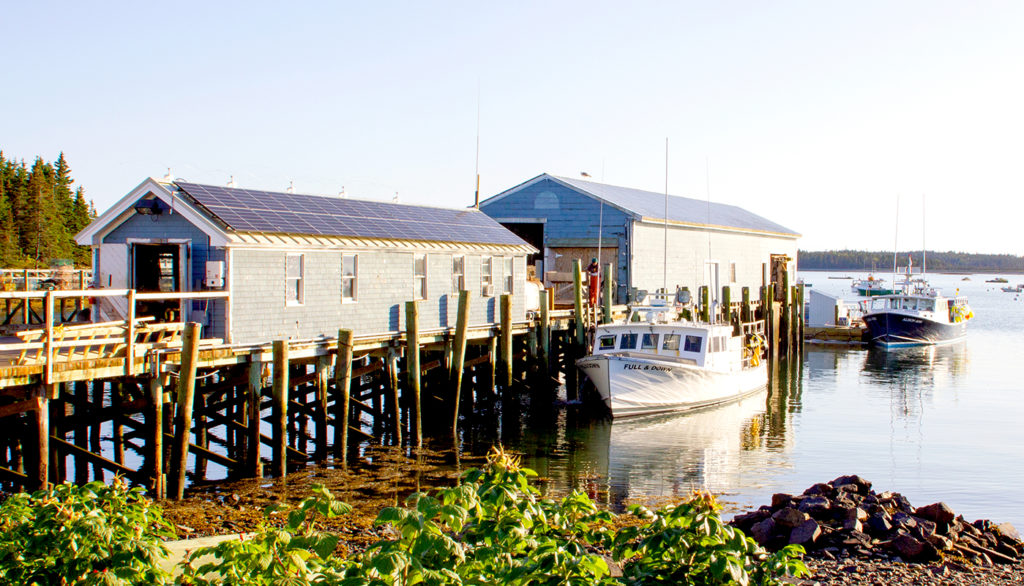The Cranberry Isles Fishermen’s Co-op, located on the island of Islesford off of Mt. Desert Island, Maine, installed a 45.4 kW solar array on their facility in 2019. Funded by grants and investments from the co-op, the system will break even after seven to nine years.
BACKGROUND
The Cranberry Isles Fishermen’s Co-op was founded in 1978, and as a part of its mission, it strives to practice environmental stewardship—particularly regarding ocean health. This commitment is seen in the measures the co-op takes to protect the natural resource it harvests, as well as on top of the very buildings in which it operates. Since the co-op promises that every lobster it sells is harvested sustainably, installing solar was a natural addition to their operations.
The co-op is comprised of owners who are boat captains that sell their lobsters to the co-op. Like most lobster co-ops along Maine’s coast, each member pays an initial membership fee and then receives an annual dividend from the co-op’s earnings relative to the number of pounds of lobster they harvested that year. The co-op also employs seven staff.
As the co-op’s operation has grown in scale over the decades, so too has its electric bills. Initially, its demand for electricity came only from a simple water pump to spray down the decks, a gas pump, and basic lighting. In 2012, their electric bills increased significantly after installing a large industrial freezer to store bait. This freezer can hold approximately 40,000 pounds of bait. Its large capacity and subsequently high electrical demand caused the co-op’s electricity bills to increase by about $2,000 a year. From there, the addition of a co-op store and its associated freezers, coolers, and heating meant that the bills continued to increase until they reached an average of about $800 a month. In 2018, the co-op studied the feasibility for on-site solar for the facility, leading to an installation on the four co-op buildings in 2019.
HOW IT WORKS
Located on the neighboring Mount Desert Island, the College of the Atlantic was instrumental in the inception of the solar project. The college was funded by the U.S. Department of Agriculture (USDA) for students to perform solar feasibility studies on local businesses. In 2018, students assessed the co-op, free-of-charge, and concluded that it was a good candidate for solar. Both the co-op and its board members agreed that the project was worth pursuing and turned their attention to funding.
In 2019, the co-op was awarded a USDA Rural Energy for America Program (REAP) grant that covers up to one-quarter of the total project cost. The project’s total cost was approximately $136,000 which included $12,000 in roof repairs. The REAP grant totaled $31,000, which was combined with a $4,000 Island Institute SPARK! grant. This brought the total cost to the co-op down to $101,000. This remaining cost was covered by a loan. At the rate they are paying back the loans, the co-op will be done making payments in seven to nine years. Separately, upon construction, the co-op acquired a $37,000 federal tax credit which was distributed among the owners of the co-op.
Sundog Solar installed the 45.4 kW solar array system on top of the four buildings that are owned by the co-op. These arrays generate approximately 110% of the electricity that the co-op uses in a given year.
Q&A WITH MARC NIGHMAN, CO-OP MANAGER
AND BRUCE FERNALD, FOUNDING CO-OP MEMBER
What does electricity use look like at the co-op? How has that changed over time?
Bruce: We’ve got refrigeration, freezers, and pumps that run all the time to aerate the lobsters in the crates and keep them frisky. The co-op store has freezers and coolers. It all requires energy. Back when we first started the co-op, we used to not have to worry about most of that. We didn’t need a freezer because we got fresh bait—we got herring for next to nothing from a factory in Southwest Harbor. Now you can’t do it without a freezer.
Marc: The amount of electricity we use changes throughout the year. We make more electricity in the summer because there’s more sunlight, but we also use significantly more. We actually have a higher net gain in the winter months because there’s less need for refrigeration, the store is closed, and only half the fleet goes out, so the pumps are used less frequently.

What was it like getting buy-in from the co-op owners?
Bruce: We ran it by the board, and then we had a co-op meeting with all the fishermen. Everyone was for it. 100% said yes.
In terms of motivations, there was a balance of business and environmentalism. Many of us thought, “If we can get clean energy, let’s do it.” Other people may not have had that at the front of their mind. But we all figured by doing solar, after everything is paid off, there will be another $10,000 to $15,000 that will get distributed through the annual dividends we pay to the fishermen. All of that will be money we save on electric bills. It was basically a no-brainer. Eventually, the only energy costs we’re going to have will be maintenance and repairs, and supposedly these things are going to last for 30 years (although they are warrantied for 20 years). Of course, there was also the $37,000 in tax credits that were divided up among the fishermen when we decided to invest in solar. Each one of them ended up getting $500-$2,000 a piece in the form of a federal tax credit.
Marc: We were able to easily convince the co-op owners because we were paying on average $800 a month for electricity, and we set it up with the bank so that the monthly loan payments were at about that same rate. So, based on that, this infrastructure doesn’t feel like it’s costing us anything, and by the year 2027, we’ll be getting free power.
What did it take to apply for the REAP grant?
Marc: First of all, the USDA REAP grant requires applicants to be agricultural or a small business. Although we aren’t technically agriculture, we do rely on natural resources. We are a relatively small business, and we are so rural that we meet their criteria.
Writing the grant was a long and drawn-out process. The people at the USDA were very helpful. They told us what to do and to call if we needed any help. However, at one point I did think about hiring someone to write it. But we decided to give it a shot and save on that cost.
When you’re trying to run a business with 15 employees, 25 fishermen, a store, and a gas station, and then you’re also trying to write grants on the side, it can get difficult. Amy, the bookkeeper and office manager, ended up being an immense help. I would start filling something out, and then hand it off and she took care of a lot of the tedium. We tag-teamed it.
Do you have any advice for others trying to fill out the grant?
Marc: The first important thing to mention is that you are required to have a System for Award Management (SAM) number and a Dun and Bradstreet number. You have to have a SAM number in order to apply for any federal grant, and the Dun and Bradstreet number is for business recognition. We pay a fee to Dun and Bradstreet, and we get listed in their database.
Pay attention to details while filling the grant out. We applied for the SAM number several times, and then weeks after submitting, we would get a notification that something in our application was incorrect, but they didn’t tell us what it was. At first, we didn’t know what needed correcting, but eventually we figured out that we were missing the apostrophe in “Cranberry Isles Fishermen’s Co-op” on our application. Little errors can set you back. My advice is to get on top of the SAM number and Dun and Bradstreet number first thing. Otherwise, it can hold you up later in the application process.
If you have the time to sit down at a computer, it’s not that bad. But when we were trying to order bait, set up sales, and keep the co-op running, it was challenging to find the time and energy. Larger companies with more capacity might have an easier time with grants like this, but we are small.
It can be frustrating, but my advice is to stick with it. Everyone at the USDA wants you to succeed. They are helpful; you just have to be patient.
Other energy efficiency measures taken?
Bruce: We’ve switched to LED lighting where we can, so that’s brought our energy usage down. And we used to have a kerosene monitor heater to heat the office and shop. That just broke this year, and we replaced it with an electric heat pump. They don’t use that much energy, so I don’t assume it will have a big impact on the electricity use. Now we’re using energy we generated ourselves to heat the buildings.
What happens when you generate more electricity than you use?
Marc: We wanted a system of arrays that could produce 110% of the energy we use, because we wanted room to grow. We ended up getting that heat pump, and down the road we might get more bait coolers. But for now, the legislation is written so that we cannot be paid directly for excess energy we produce. Instead, we get credits that we can use. We gain credits in the slow winter months that can be used during the busy summer and autumn months. Those credits expire 12 months after we earn them. We came pretty close this year, and we didn’t generate too much extra electricity. The good news is if we do end up with too many credits, they can be transferred to the owners of the co-op.
Author’s Note: State regulations on net energy billing dictate how customers can offset their electricity bills using the output from small renewable energy projects.
What role did environmental stewardship play in the decision to go solar?
Marc: Climate change is getting worse and worse, and at the Cranberry Isles Fishermen’s Co-op we take that seriously… especially considering we make our livings out on the ocean and are influenced by ocean acidification and water temperature changes. It was a driving factor for us.
RESULTS
Sundog Solar installed a 45.4 kW solar arrays system on the four co-op buildings in 2019. After one year, they are generating slightly more electricity than the co-op uses. Their current loan payments are close to the amount of their electricity bills prior to installing solar. At this rate, their loan will be paid off around the year 2027, at which point their electric expenses will be reduced to a small service charge.
RESOURCES
- Cranberry Isles Fishermen’s Co-op website
- Sundog Solar website
- USDA.gov – Rural Energy for America Program (REAP) information
- Efficiency Maine – Rebate and Tax Credit information
- Energy.gov – Funding opportunities and Tax credit information
Up-to-date Information on State of Maine regulations for offsetting electricity use through renewable energy projects:
The interview above has been edited for clarity and length.



